The Arctic is not a country but an area that describes the Earth’s northernmost region. Several countries have territory in the Arctic Circle, including:
- Canada
- Greenland
- Finland
- Iceland
- Norway
- Russia
- Sweden
- United States
This area of the world has extreme weather conditions. In winter, temperatures can reach depths of -40 degrees Fahrenheit, but the coldest temperature ever recorded there is -90 degrees Fahrenheit. Though it may seem snowy there, it only snows about 20 inches per year. The Arctic Sea is covered in ice in many places.
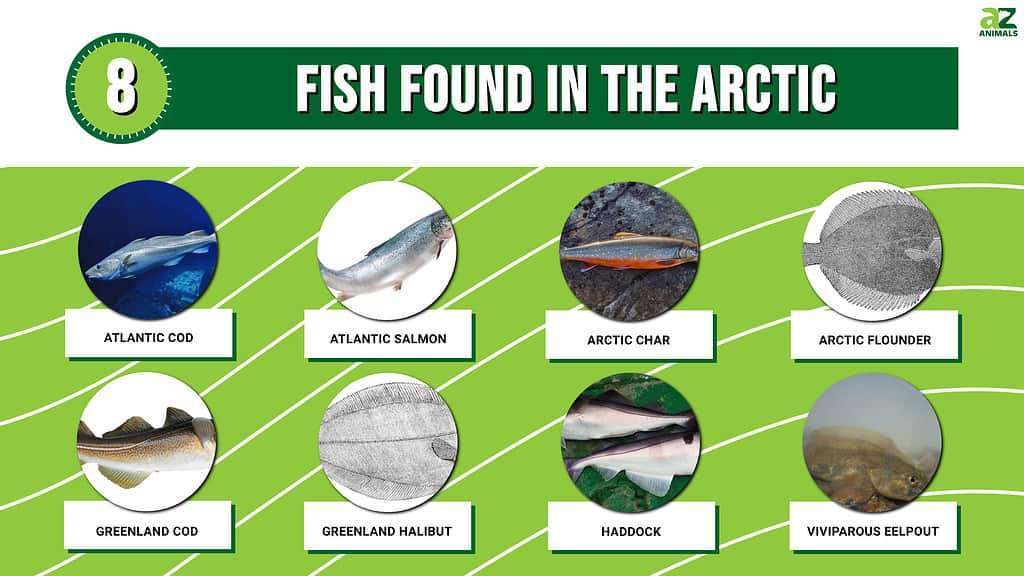
Unfortunately, the Arctic is shrinking by about 35 miles per decade. Experts believe this is due to climate change. Arctic sea ice may be completely gone anytime between the years 2035 and 2067.
Though it may seem like a hard place to survive, there are plenty of plants and animals in the Arctic. The Arctic Sea is teeming with life, including many fish species and marine mammals. Which fish live in the Arctic?
1. Atlantic Cod
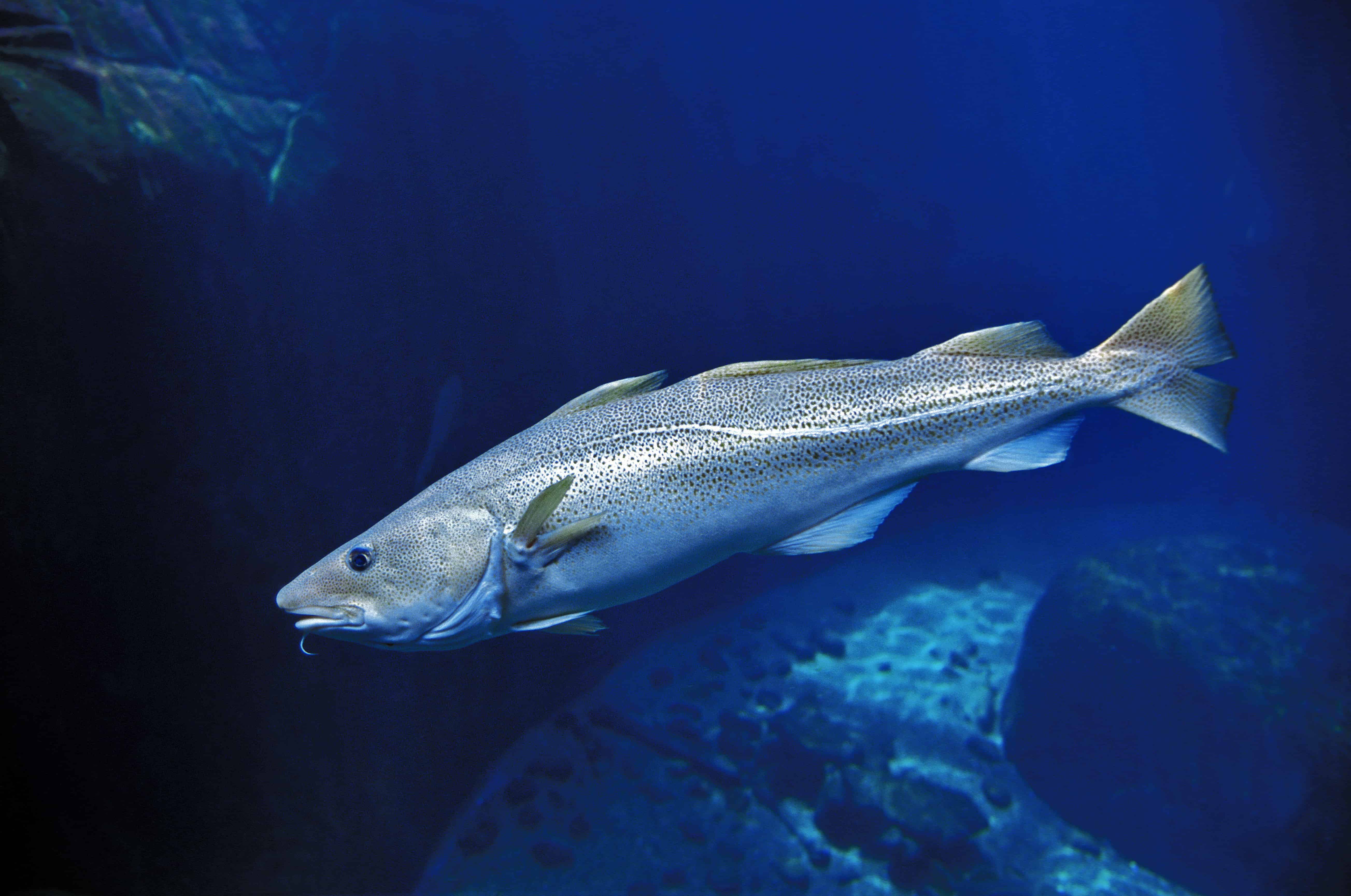
The Atlantic cod is carnivorous and eats other fish, including members of their own species, sea worms, and shellfish.
©slowmotiongli/Shutterstock.com
This popular food fish is found all throughout the Atlantic Ocean and north into the Arctic Sea. While they have been known to grow up to 70 inches long, most average catches are between 40 and 55 inches. These brownish-green fish with black spots on them live for up to 25 years. It has been important for the commercial trade of fish for at least 1,000 years. However, overfishing in the 90s has put this once plentiful species at risk. Since then, conservation efforts have helped their population to come back.
They are now labeled as overall “vulnerable” to extinction at this point. However, in some areas, like Europe, their population has rebounded sufficiently. There, they are labeled as not a concern for extinction.
The Atlantic cod is carnivorous and eats other fish, including members of their own species, sea worms, and shellfish. The type of Atlantic cod that comes from the Arctic Sea is specifically referred to as Northeast Arctic cod in the commercial fish trade.
2. Atlantic Salmon

Atlantic salmon develop a silver-blue sheen with black spots above the lateral line when they go to sea to mature.
©Alexander Raths/Shutterstock.com
The Atlantic salmon is another important food fish with a connection to the Arctic. This species goes by many other names, including:
- Bay salmon
- Black salmon
- Caplin-scull salmon
- Fiddler
- Sebago salmon
- Silver salmon
- Outside salmon
- Winnish
- Landlocked salmon
- Ouananiche
- Spring Salmon
- Parr
- Grilse
- Kelt
- Slink
These fish grow to be about 30 inches long and weigh up to around 12 pounds. However, elder members of the species can be much larger. One Atlantic salmon found in 1960 was 63 inches long and weighed over 100 pounds! These fish prefer to live in colder water and follow an annual migration pattern to stay in cold ocean waters and then return to their breeding grounds in rivers.
Atlantic salmon have a very specific lifecycle. They stay in the freshwater river where they were born for between 2 and 8 years. Once they are large enough, they head to the ocean between March and June, where they continue to eat and grow. Once they are large enough to breed, they head back to the river where they were born for breeding. Unlike other salmon species, Atlantic salmon do not die after spawning only one time. Some individuals return to sea and come back to spawn again. Some Atlantic salmon that live in lakes do not return to the sea. They stay in the same place for their whole lives.
Atlantic salmon is an incredibly popular food fish. It is sold fresh and frozen, as well as canned. They have been fished for in the United States for thousands of years. They are also popular for aquaculture. This species is listed as the least concern for extinction, but there are still some conservation concerns. For example, salmon have been locally extinct (extirpated) from several individual lakes. Additionally, habitat loss is a concern. However, conservation efforts to restore access to breeding grounds with tools like fish ladders have proven successful in some places.
3. Arctic Char
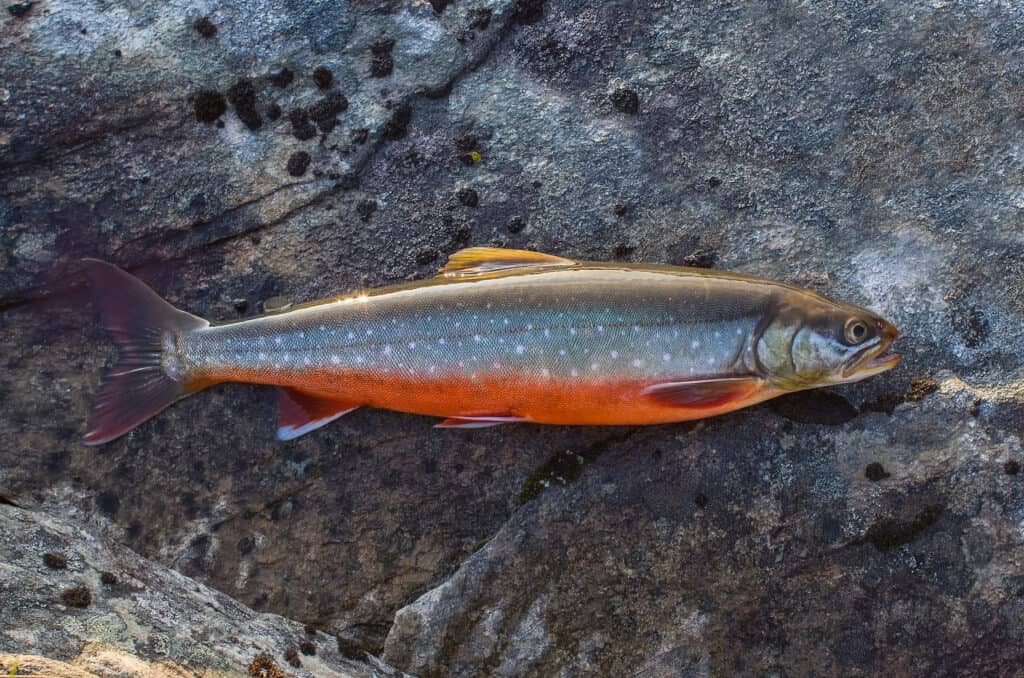
Arctic char is said to taste like something between salmon and trout.
©FedBul/Shutterstock.com
Arctic chars have a similar lifecycle pattern to Atlantic salmon. They live in the ocean and then return to their freshwater breeding grounds to spawn. Similar to salmon, arctic chars that live in lakes without ocean access remain in the lakes for their whole life cycle. It is the freshwater fish that can survive the furthest north. They are the only fish present in some Arctic lakes, such as Lake Hazen.
These fish are an average of 16 inches long and weigh up to 9 pounds. There are also dwarf Arctic chars which are just 3 inches long and weigh up to 5 pounds.
A popular food fish, Arctic char, is said to taste like something between salmon and trout. According to the Monterey Bay Aquarium Seafood Watch program, they are one of the best choices for fish consumers.
4. Arctic Flounder
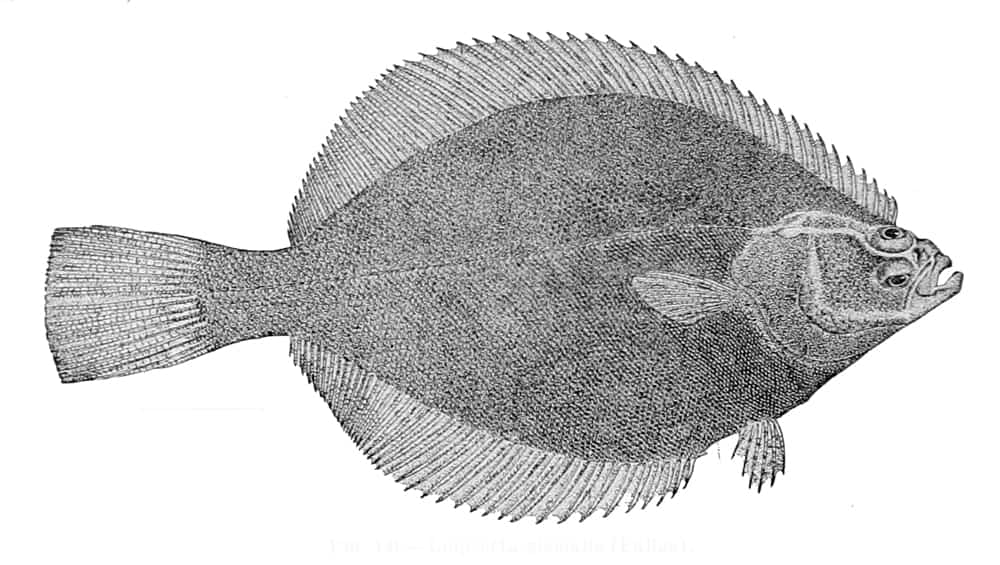
The Arctic flounder is one of more than 100 flounder species.
©public domain – License
Other names for the Arctic flounder include Christmas flounder, eelback flounder, and Polar plaice. They grow up to 14 inches long. They are found in muddy flats in saltwater, brackish water, and freshwater in the Arctic and northeastern Atlantic oceans.
In general, flounder is a popular food fish. They are bottom dwellers that sit patiently and wait for their next meal to come by. The Arctic flounder is one of more than 100 flounder species. Flounder is one of the most popular fish to eat around the world. People eat it baked, fried, grilled, and in other preparations.
5. Greenland Cod
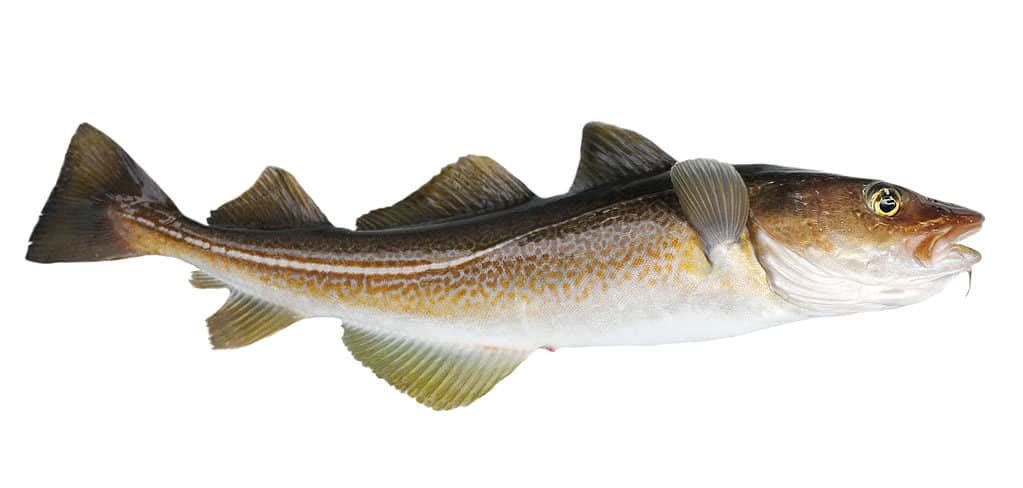
Another name for Greenland cod is ogac.
©xpixel/Shutterstock.com
Greenland cod is a brownish fish that is found in the Arctic Ocean as well as the northwestern Pacific Ocean. They grow up to an average of 30 inches long. They are a highly desired commercial fish, but less so than Atlantic cod. This is because their meat is a bit tougher than the latter species.
Another name for Greenland cod is ogac. This is its name in the Inuktitut language of the indigenous people of Central and Eastern Arctic Canada. This fish looks somewhat similar to the Atlantic cod but does not have spots on its body.
6. Greenland Halibut
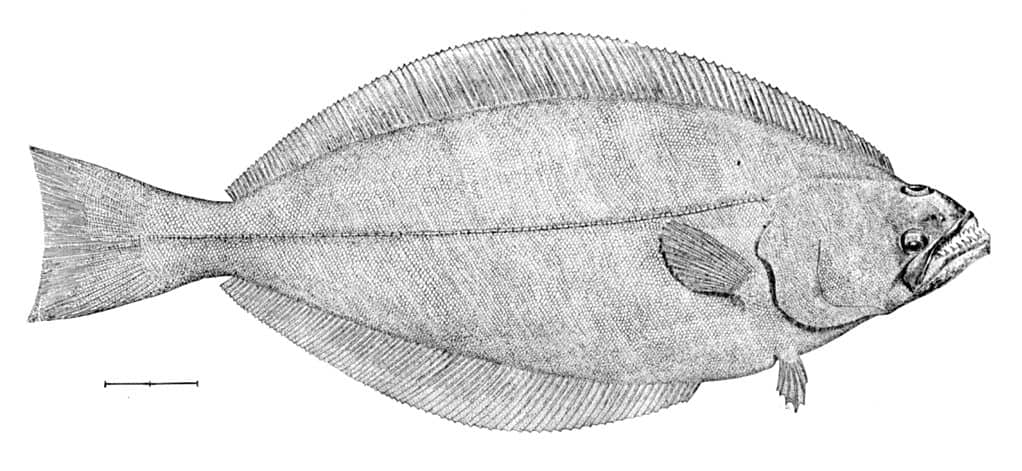
The Greenland halibut is more often used for sled dog food in Greenland and salted, smoked, or frozen in other parts of the world.
©public domain – License
The Greenland halibut lives in the Northern Atlantic, Northern Pacific, and Arctic Oceans. It also goes by the names:
- Black halibut
- Blue halibut
- Lesser halibut
- Newfoundland turbot
- Greenland turbot
- Hellefisk
One unique fact about this flatfish is that its left eye has migrated toward its right side. So, it is more in the center of the fish and gives them a cyclops appearance. They grow up to 3.9 feet long and weigh up to 99 pounds, but they are more like 3 feet long and 25-50 pounds on average.
They are important for commercial fishing and yearly hauls have been between 50 and 140 tons since 1960. Even though they are not considered endangered at this time, Greenpeace added them to their seafood red list because the primary method used for fishing this species, bottom trawling, can cause damage to the environment and can also lead to overfishing.
While this fish is used commercially, it is more often used for sled dog food in Greenland and salted, smoked, or frozen in other parts of the world. However, it is not as popular as other halibut species like Atlantic halibut and European turbot. This is because due to its high fat content and thick skin, about 1/3 of each fish is not edible meat.
7. Haddock

Similar to the cod, haddock is often caught for culinary purposes.
©Solodov Aleksei/Shutterstock.com
Haddocks are found in the North Atlantic Ocean as well as the Barents Sea, which is part of the Arctic Ocean. They grow to be over 30 inches long and weigh up to 24 pounds. They range in color from dark grey to black.
This is a very popular food for fish. In the UK, it is most commonly used for fish and chips. In Norway, it is used in fiskeboller, Norwegian fishballs. It is also sold smoked, frozen, dried, and canned in many areas of the world. In Boston, haddock is sold as scrod.
Similar to Greenland halibut, they are on Greenpeace’s red list due to the use of bottom trawling for fishing. However, the Monterey Bay Aquarium lists haddock as a good alternative to some other less sustainably fished species. Many haddock fisheries use sustainable practices to help keep haddock populations going strong so people can enjoy this fish for years to come.
8. Viviparous Eelpout
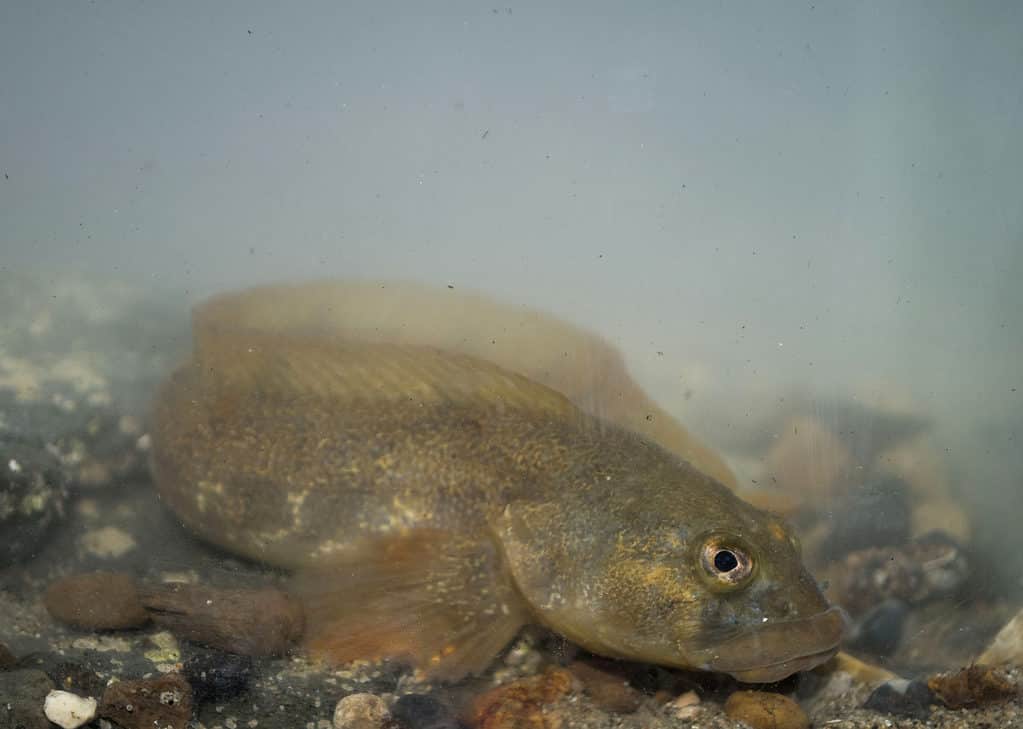
One unique fact about viviparous eelpouts is that they have one of the longest pregnancies of any fish.
©jack perks/Shutterstock.com
This unique fish has green bones and slimy skin. Despite that these qualities might be offputting to some people, it’s a popular food fish in Mediterranean countries. They typically weigh just over one pound and can grow up to 20 inches long, although they are more commonly a foot long. They are present in The Atlantic Ocean from the English Channel, east to the Baltic Sea, through the North Sea, as well as around the North Sea and the Barents Sea, the latter of which is part of the Arctic Ocean.
One unique fact about viviparous eelpouts is that they have one of the longest pregnancies of any fish. They stay pregnant for about six months. Viviparous eelpout mothers also have the ability to nurse their offspring with a secretion that is similar to milk – but not exactly. It is a combination of protein, fatty acids, and glucose that is secreted through ovarian follicles – similar to nipples. They are one of the only fish in the world with this ability.
The photo featured at the top of this post is © Maridav/Shutterstock.com
FAQs (Frequently Asked Questions)
Is the Arctic a country?
No, the Arctic is not a country.
What are some fish species found in the Arctic?
Atlantic cod, Atlantic salmon, and Arctic char are a few of the fish species found in the Arctic.
How cold does it get in The Arctic?
The coldest temperature ever recorded in The Arctic was -90 degrees Fahrenheit.
Why is The Arctic shrinking?
Experts believe The Arctic is shrinking due to climate change.
How fast is the Arctic shrinking?
The Arctic is shrinking by about 35 miles per decade.
Thank you for reading! Have some feedback for us? Contact the AZ Animals editorial team.






